How To Repair Peeling Drywall
From pocket-sized to major repairs, detailed step-by-stride directions on how to fix impairment to drywall
Most drywall repairs are simple, consisting of patching holes, filling dents, and embedding popped nails. They require only basic tools and some drywall joint chemical compound, available at Amazon. As well be prepared to touch up or pigment the repaired surface area.
Such pocket-size flaws as dents and small nail holes can be repaired by filling the surface area with vinyl spackling compound afterwards sanding it make clean. Choose a putty knife appropriately sized to the blotch, and, if more i layer of compound is required, brand sure you allow each layer to dry completely between applications.
Popped nails can be stock-still by tapping the popped nail beneath the wall's surface and so driving a 2nd nail or drywall screw next to information technology to concord the start nail in identify. Dimples can be filled with joint compound. Meet more about these repairs below.
How to Prepare Holes in Drywall
To fix a modest hole, fill information technology with vinyl spackling compound, merely starting time slightly paring the surface with a hammer to produce a void.
Clean the hole and dampen information technology with a sponge. Apply the compound with a 3-inch putty knife, drawing it smoothly over the dent, flush with the wall's surface.
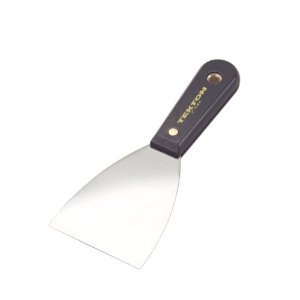
For a medium-sized hole, put cocky-agglutinative fiberglass mesh drywall joint tape over the hole first, and then apply vinyl spackling compound.
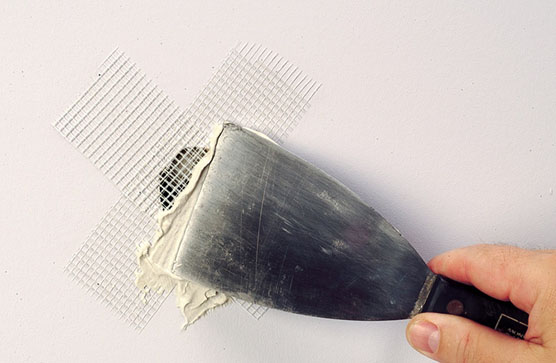

If a wall has a large dent or hole, the damaged surface area must be replaced with a new piece of drywall of identical thickness. The tricks involved in doing this well are ane) to fasten the new replacement slice securely, even where wall studs are not available for attachment, and two) to blend in the new slice of drywall with the rest of the surface so information technology appears seamless.
For deeper or larger holes, drywall repair kits are sold that usually include either uncomplicated metal clips that support a replacement piece or some sort of backerboard that inserts into the hole and suspends itself in place while yous cover it with joint compound. Browse drywall repair kits at Amazon.
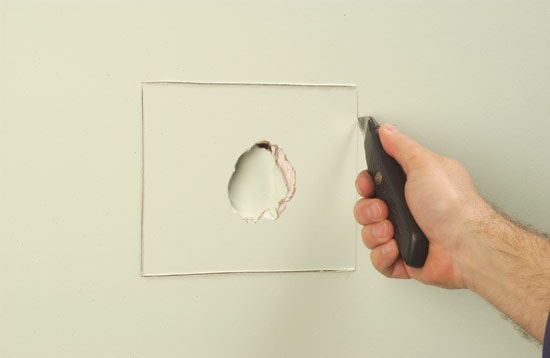

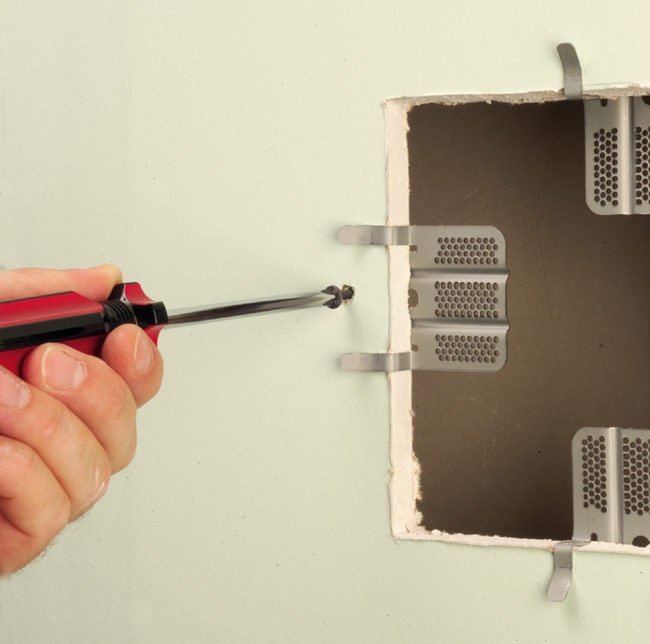

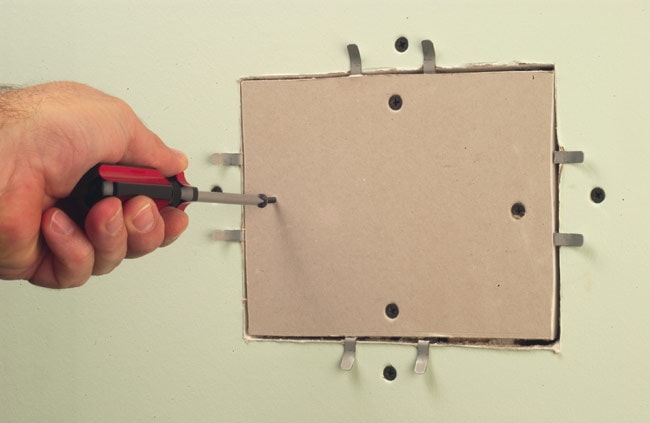

Alternatively, yous can make your ain drywall patch from a small piece of drywall. Before applying the patch, yous cut the pigsty in the wall to a rectangular shape that fits the patch, using a utility knife, saber saw, or jab saw. If y'all use a utility pocketknife, yous will demand to score repeatedly along a straightedge to cut all the way through the drywall.
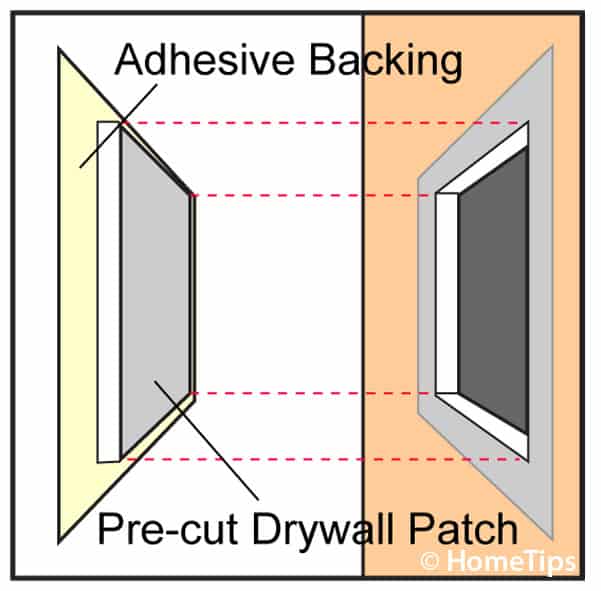
If necessary to hold the patch, you lot can make your own backerboard from a piece of scrap plywood or drywall. Thoroughly smear the backerboard with joint compound (this "glues" it to the inside wall face), and use a string to agree it in identify while the compound dries. Then just cut the string off and utilise more compound to smooth out the repair, as detailed above.
If the pigsty is deep, allow the patch to dry out, sand lightly with 120-grit sandpaper, and reapply spackling compound. Sand very lightly and and then bear on upwardly with paint to match.
If the pigsty is very large, it's oftentimes improve to cutting the drywall back to a stud on each side of the break. Use a screw gun to fasten a two-by-4 nailer to the open face of each stud and and then cut a new piece of drywall to fit the opening. Tape and compound all of the joints as you would in new drywall installation. (For more most repairing the surface of a drywall wall, see How to Repair Drywall (Sheetrock).
The best way to attach the replacement piece will depend on its size and whether or not there are wall studs backing information technology. Once the replacement piece is deeply attached, blending in the surface and so the repair is not noticeable usually requires three applications of drywall joint compound. Considering the area has to dry completely after each awarding, this can have a couple of days.
To exercise this, your supplies volition include prepare-mix joint chemical compound; 2-inch drywall tape, either perforated or mesh; taping knives in 4-, 6-, and ten-inch sizes; and 400-grit sandpaper and a sanding block.
Load almost one-half of a 4-inch taping-knife blade with joint chemical compound and, belongings the knife at a 45-caste angle, use information technology to the seams. Utilize the next layer with a 6-inch bract after the outset layer is completely dry, ordinarily after 24 hours. Exercise the aforementioned for the 3rd layer, only this time use the 10-inch bract. Finally, smooth the surface when it is completely dry with a wet sponge and sand the seams with the sandpaper wrapped around the sanding cake.
How to Set up Drywall Cracks
Hairline cracks in drywall, especially at the top corners of windows and doors, are signs that the wall framing has settled or moved a little—a common condition and one that's like shooting fish in a barrel to repair. Just, if the crevice isn't repaired properly, it's probable to reappear.
i Using a utility knife with a sharp bract, widen the crack in the drywall so that it has a Five-shaped profile that will readily accept compound.
2 Using a broad-bladed putty knife, spread joint chemical compound over the groove so that it fills the area and covers an inch or two on either side. Smooth the compound and then let it to dry.
3 Employ self-agglutinative fiberglass articulation tape over the groove. Scan fiberglass joint tape at Amazon.
4 Using a 5-inch drywall knife, completely cover the tape with a 2d coat of joint compound, "feathering out" the compound smoothly and evenly a couple of inches beyond the earlier coat. Allow it to dry.
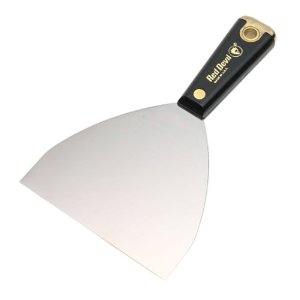
5 Sand the area shine with fine sandpaper. (Be conscientious not to sand downwards to the tape or to scuff the paper surface of the surrounding wallboard.)
half-dozen Affect up with paint to lucifer (or repaint the entire wall for a truly seamless repair).
How to Repair Drywall Corners
Drywall corners are vulnerable to getting banged and hobbling past traffic through a house. Below the joint compound that covers and finishes the corner is a length of lightweight metallic "corner bead" with either a right-angle or curved profile. The object is to straighten out this dented piece of metallic and re-encompass it with drywall compound. Here's how to practice it:
ane Use a utility knife to cut abroad loose drywall compound from the damaged area.
ii Reshape the dented corner bead. To sculpt flattened or bent areas, gently pound a bolt or an upside-down nailset with a hammer.
three Tack down 1 edge of the loose metal corner bead with drywall nails.
4 Using a putty knife, remove all loose existing joint chemical compound.
5 Tack downwardly the other edge of the metal corner bead to secure information technology.
vi Using a 6-inch-broad drywall knife, fill i side of the corner and draw it out so that it's smooth. Permit the compound to dry.
7 Make full the corner'due south other side, smoothen it out, and let the compound to dry.
eight Gently sand with fine sandpaper wrapped around a block. Fill up with a second coat if necessary and sand over again.
How to Set Peeling Drywall Tape
Drywall tape can pare for a variety of reasons—poor application, high room humidity, nail pops, fifty-fifty destructive kids and pets. You can make repairs easily, only it may continue happening unless y'all eliminate the crusade, such as by placing a dehumidifier in a room where dampness persists.
If the problem is confined to a pocket-size area, you don't need professional person drywall skills to do an adequate task, merely if the tape is peeling off the walls in several places, or in areas of prominent visibility, consider calling in a pro who tin can give y'all quality results. Here's how to do it:
1 Use a sharp razor knife to cut away each end of the tape a foot or so beyond the damaged surface area. Sand down the remaining ridges of stale drywall chemical compound with a moderately coarse drywall sanding pad. Sand virtually to the drywall surface (y'all don't want to go as well far and cut into the drywall paper), and vacuum away the dust.
2 Use a v-inch taping knife to lay a thin bed of joint compound over the drywall articulation. The compound should be uniform in thickness and width, with no gaps or large air pockets, and should extend at to the lowest degree 2 inches on each side of the joint. Browse taping knives on Amazon.
3 Cut a piece of drywall record slightly shorter than the missing tape department. Place it atop the joint and apply your taping pocketknife to smooth the new tape into the compound. Be certain there is no air trapped nether the tape or wrinkles anywhere along its length.
4 Smooth a second thin coat of articulation compound over the tape. Keep the knife blade flat and take intendance not to disturb the tape'due south position. Allow it to dry overnight.
5 Carefully sand and scrape away any high spots where the compound has dried, and so use a wide-bladed taping knife to lay another bed of joint compound over the unabridged area of repair. Allow information technology to dry thoroughly. Sand again, using progressively finer sanding sheets to blend, or "feather," the compound into the rest of the wall surface.
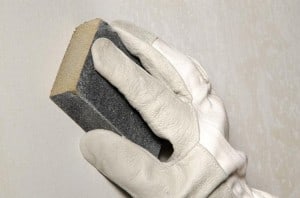
How to Fix Popped Drywall Nails
When wall studs and ceiling joists bend and twist, which often happens in new homes congenital with woods that dries after it is installed, the framing members tin push and pull away from the drywall, causing the drywall nails to pop out of the wood.
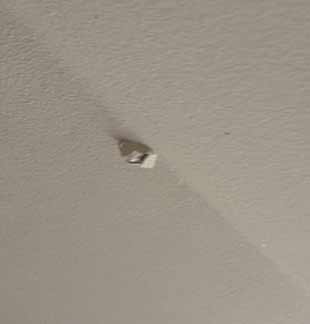
This usually happens near the center of the boards, where the almost pronounced bending is likely to occur. If it'due south too late to telephone call the architect back to take care of this badgerer (it's rarely structurally threatening), you tin do the repair yourself.
Earlier beginning any repairs, first constitute that they really are nails since newer houses apply drywall screws instead. Hither'due south how to fix a popped blast:
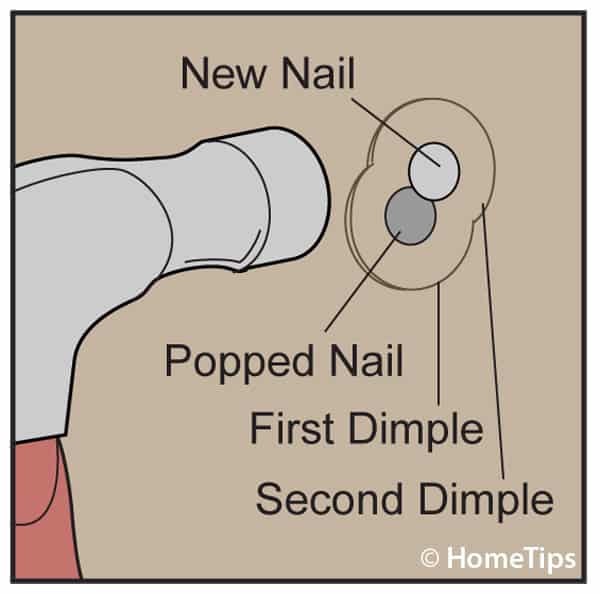
Don't pull out the former nail. Instead, bulldoze a second smash—or better yet, bulldoze a drywall screw—in near each popped smash to re-anchor the drywall at that spot and then tap the original boom back in identify.
If the nails beetle far enough, they tin tear or button the drywall tape off the wall. Where this happens, you'll have to cutting away and supercede the tape. Cut back merely as far as necessary—the ends of the tape withal firmly embedded in joint compound should non have to exist removed.
Use joint compound to comprehend the nails or screws. When that has stale, sand the area, prime number, and paint.
Featured Resource: Find Pre-Screened Local Drywall Repair Help
Source: https://www.hometips.com/repair-fix/sheetrock-drywall.html

0 Response to "How To Repair Peeling Drywall"
Post a Comment